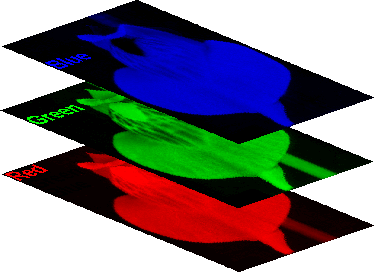Home Sensing Primer Glossary Physics Related Technologies Acknowledgements
Multispectral Digital Data
 A stack of three images |
Multispectral image data consists of separate images, each made from photons confined to separate
wavelength bands. Consider the three images in discussed on the previous page. These three images
represent multispectral data at three bands. For each x-y point in that image set, you have three pieces of photon-intensity data (one for
each wavelength band). This could be thought of as a multispectral data "stack," artfully shown on the right. The key to
multispectral imagery is that all the images span the same area (e.g. the same patch of forest), and are taken simultaneously (or
close enough to simultaneously that temporal effects are not important). The differences from image to image in the stack can be
therefore attributed to purely spectral features of the study area.
Multispectral data can be obtained in a number of ways. A single camera can take a sequence of images, constantly
switching in front of the detector one filter after another. Alternately, three or more cameras (each equipped with a different filter)
are mounted on a single platform and simultaneously record images. The research team selects which filters are to be used, and their
choices are determined by their research goals. A commonly used set of bands in vegetation remote sensing is color-infrared
(green, red, and infrared), as described here. In satellite imagery, the available bands are set by the
satellite designers before the launch date, and so cannot be modified by the ground-based observers.
Commonly used sources of multispectral imagery includes the Landsat 7
(and archived data from earlier Landsat missions), AVHRR, IKONOS, and SPOT missions.
It is useful to compare this multispectral data stack to the concept of the data-cube on the next page, so glance at that
page even if you are not
interested in hyperspectral data.